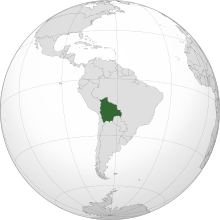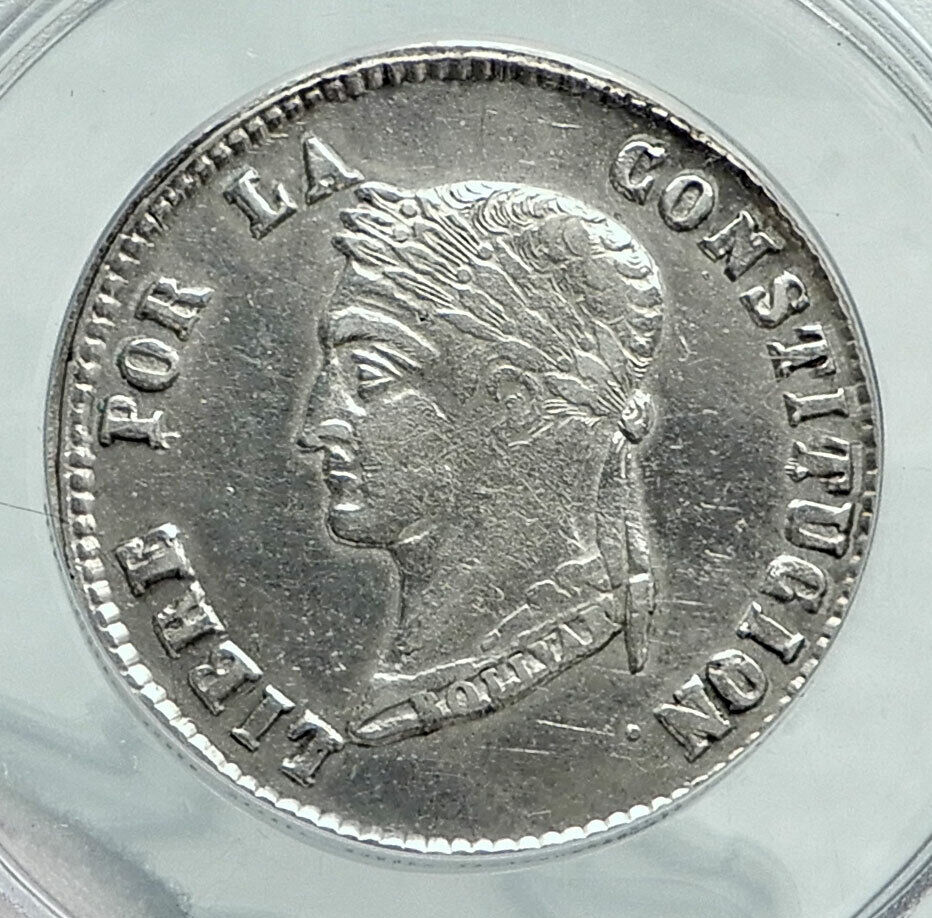|
Bolivia
Charles III – King of Spain: 10 August 1759 – 14 December 1788
1776 Silver 2 Reales 27mm (6.77 grams) 0.903 Silver
Reference: KM# 53 (1773-89)
Certification: NGC GOOD DETAILS 4434595-001
CAROLUS. III. DEI. GRATIA. 1774. Bust of Charles III facing right.
.HISPAN. ET IND. REX. PTS. 2R. J.R., Pillars flanking crowned Coat-of-Arms.
You are bidding on the exact item pictured, provided with a Certificate of Authenticity and Lifetime Guarantee of Authenticity.
 Charles III (Charles Sebastian; Spanish: Carlos Sebastián; Italian and Neapolitan: Carlo Sebastiano; Sicilian: Carlu Bastianu; 20 January 1716 – 14 December 1788) was King of Spain (1759–1788). He also was Duke of Parma and Piacenza, as Charles I (1731–1735); King of Naples, as Charles VII, and King of Sicily, as Charles V (1734–1759). He was the fifth son of Philip V of Spain, and the eldest son of Philip’s second wife, Elisabeth Farnese. A proponent of enlightened absolutism and regalism, he succeeded to the Spanish throne on 10 August 1759, upon the death of his childless half-brother Ferdinand VI. Charles III (Charles Sebastian; Spanish: Carlos Sebastián; Italian and Neapolitan: Carlo Sebastiano; Sicilian: Carlu Bastianu; 20 January 1716 – 14 December 1788) was King of Spain (1759–1788). He also was Duke of Parma and Piacenza, as Charles I (1731–1735); King of Naples, as Charles VII, and King of Sicily, as Charles V (1734–1759). He was the fifth son of Philip V of Spain, and the eldest son of Philip’s second wife, Elisabeth Farnese. A proponent of enlightened absolutism and regalism, he succeeded to the Spanish throne on 10 August 1759, upon the death of his childless half-brother Ferdinand VI.
In 1731, the 15-year-old Charles became the Duke of Parma and Piacenza, as Charles I, following the death of his childless grand-uncle Antonio Farnese. In 1738 he married Princess Maria Amalia of Saxony, daughter of Augustus III of Poland, who was an educated, cultured woman. The couple had 13 children, eight of whom reached adulthood, including Charles, heir to the Spanish throne. Charles and Maria Amalia resided in Naples for 19 years. He gained valuable experience in his 25-year rule in Italy, so that he was well prepared as monarch of the Spanish Empire. His policies in Italy prefigured ones he would put in place in his 30-year rule of Spain.
As King of Spain, Charles III made far-reaching reforms to increase the flow of funds to the crown and defend against foreign incursions on the empire. He facilitated trade and commerce, modernized agriculture and land tenure, and promoted science and university research. He implemented regalist policies to increase the power of the state regarding the church. During his reign, he expelled the Jesuits from the Spanish Empire. He strengthened the Spanish army and navy. Although he did not achieve complete control over Spain’s finances, and was sometimes obliged to borrow to meet expenses, most of his reforms proved successful in providing increased revenue to the crown and expanding state power, leaving a lasting legacy. In the Spanish Empire his regime enacted a series of sweeping reforms with the aim of bringing the overseas territories under firmer control by the central government, reversing the trend toward local autonomy, and gaining more control over the Church. Reforms including the establishment of two new viceroyalties, realignment of administration into intendancies, creating a standing military, establishing new monopolies, revitalizing silver mining, excluding American-born Spaniards (criollos) from high civil and ecclesiastical offices, and eliminating many privileges (fueros) of clergy.
Historian Stanley Payne writes that Charles III “was probably the most successful European ruler of his generation. He had provided firm, consistent, intelligent leadership. He had chosen capable ministers….his personal life had won the respect of the people.” John Lynch’s assessment is that in Bourbon Spain “Spaniards had to wait half a century before their government was rescued by Charles III.”
.svg/125px-Flag_of_Bolivia_(state).svg.png) Bolivia, officially the Plurinational State of Bolivia (Spanish: Estado Plurinacional de Bolivia), is a landlocked country located in western-central South America. The capital is Sucre while the seat of government is located in La Paz. The largest city and principal economic and financial center is Santa Cruz de la Sierra, located on the Llanos Orientales (tropical lowlands) a mostly flat region in the east of Bolivia. Bolivia, officially the Plurinational State of Bolivia (Spanish: Estado Plurinacional de Bolivia), is a landlocked country located in western-central South America. The capital is Sucre while the seat of government is located in La Paz. The largest city and principal economic and financial center is Santa Cruz de la Sierra, located on the Llanos Orientales (tropical lowlands) a mostly flat region in the east of Bolivia.

It is constitutionally a unitary state, divided into nine departments. Its geography varies from the peaks of the Andes in the West, to the Eastern Lowlands, situated within the Amazon Basin. It is bordered to the north and east by Brazil, to the southeast by Paraguay, to the south by Argentina, to the southwest by Chile, and to the northwest by Peru. One-third of the country is within the Andean mountain range. With 1,098,581 km2 (424,164 sq mi) of area, Bolivia is the 5th largest country in South America and the 27th largest in the world.
 The country’s population, estimated at 11 million, is multiethnic, including Amerindians, Mestizos, Europeans, Asians and Africans. The racial and social segregation that arose from Spanish colonialism has continued to the modern era. Spanish is the official and predominant language, although 36 indigenous languages also have official status, of which the most commonly spoken are Guarani, Aymara and Quechua languages. The country’s population, estimated at 11 million, is multiethnic, including Amerindians, Mestizos, Europeans, Asians and Africans. The racial and social segregation that arose from Spanish colonialism has continued to the modern era. Spanish is the official and predominant language, although 36 indigenous languages also have official status, of which the most commonly spoken are Guarani, Aymara and Quechua languages.
Before Spanish colonization, the Andean region of Bolivia was part of the Inca Empire, while the northern and eastern lowlands were inhabited by independent tribes. Spanish conquistadors arriving from Cuzco and Asunción took control of the region in the 16th century. During the Spanish colonial period Bolivia was administered by the Royal Audiencia of Charcas. Spain built its empire in great part upon the silver that was extracted from Bolivia’s mines. After the first call for independence in 1809, 16 years of war followed before the establishment of the Republic, named for Simón Bolívar. Over the course of the 19th and early 20th century Bolivia lost control of several peripheral territories to neighboring countries including the seizure of its coastline by Chile in 1879. Bolivia remained relatively politically stable until 1971, when Hugo Banzer led a coup d’état which replaced the socialist government of Juan José Torres with a military dictatorship headed by Banzer; Torres was murdered in Buenos Aires, Argentina by a right-wing death squad in 1976. Banzer’s regime cracked down on leftist and socialist opposition and other forms of dissent, resulting in the torture and deaths of a number of Bolivian citizens. Banzer was ousted in 1978 and later returned as the democratically elected president of Bolivia from 1997 to 2001.
Modern Bolivia is a charter member of the UN, IMF, NAM, OAS, ACTO, Bank of the South, ALBA and USAN. For over a decade Bolivia has had one of the fastest economic growths in Latin America, however it remains one of the poorest countries in South America. It is a developing country, with a medium ranking in the Human Development Index, a poverty level of 38.6 percent, and it has one of the lowest crime rates in Latin America. Its main economic activities include agriculture, forestry, fishing, mining, and manufacturing goods such as textiles, clothing, refined metals, and refined petroleum. Bolivia is very rich in minerals, especially tin.
|









 Charles III (Charles Sebastian; Spanish: Carlos Sebastián; Italian and Neapolitan: Carlo Sebastiano; Sicilian: Carlu Bastianu; 20 January 1716 – 14 December 1788) was King of Spain (1759–1788). He also was Duke of Parma and Piacenza, as Charles I (1731–1735); King of Naples, as Charles VII, and King of Sicily, as Charles V (1734–1759). He was the fifth son of Philip V of Spain, and the eldest son of Philip’s second wife, Elisabeth Farnese. A proponent of enlightened absolutism and regalism, he succeeded to the Spanish throne on 10 August 1759, upon the death of his childless half-brother Ferdinand VI.
Charles III (Charles Sebastian; Spanish: Carlos Sebastián; Italian and Neapolitan: Carlo Sebastiano; Sicilian: Carlu Bastianu; 20 January 1716 – 14 December 1788) was King of Spain (1759–1788). He also was Duke of Parma and Piacenza, as Charles I (1731–1735); King of Naples, as Charles VII, and King of Sicily, as Charles V (1734–1759). He was the fifth son of Philip V of Spain, and the eldest son of Philip’s second wife, Elisabeth Farnese. A proponent of enlightened absolutism and regalism, he succeeded to the Spanish throne on 10 August 1759, upon the death of his childless half-brother Ferdinand VI..svg/125px-Flag_of_Bolivia_(state).svg.png) Bolivia, officially the Plurinational State of Bolivia (Spanish: Estado Plurinacional de Bolivia), is a landlocked country located in western-central South America. The capital is Sucre while the seat of government is located in La Paz. The largest city and principal economic and financial center is Santa Cruz de la Sierra, located on the Llanos Orientales (tropical lowlands) a mostly flat region in the east of Bolivia.
Bolivia, officially the Plurinational State of Bolivia (Spanish: Estado Plurinacional de Bolivia), is a landlocked country located in western-central South America. The capital is Sucre while the seat of government is located in La Paz. The largest city and principal economic and financial center is Santa Cruz de la Sierra, located on the Llanos Orientales (tropical lowlands) a mostly flat region in the east of Bolivia. 
 The country’s population, estimated at 11 million, is multiethnic, including Amerindians, Mestizos, Europeans, Asians and Africans. The racial and social segregation that arose from Spanish colonialism has continued to the modern era. Spanish is the official and predominant language, although 36 indigenous languages also have official status, of which the most commonly spoken are Guarani, Aymara and Quechua languages.
The country’s population, estimated at 11 million, is multiethnic, including Amerindians, Mestizos, Europeans, Asians and Africans. The racial and social segregation that arose from Spanish colonialism has continued to the modern era. Spanish is the official and predominant language, although 36 indigenous languages also have official status, of which the most commonly spoken are Guarani, Aymara and Quechua languages. 




